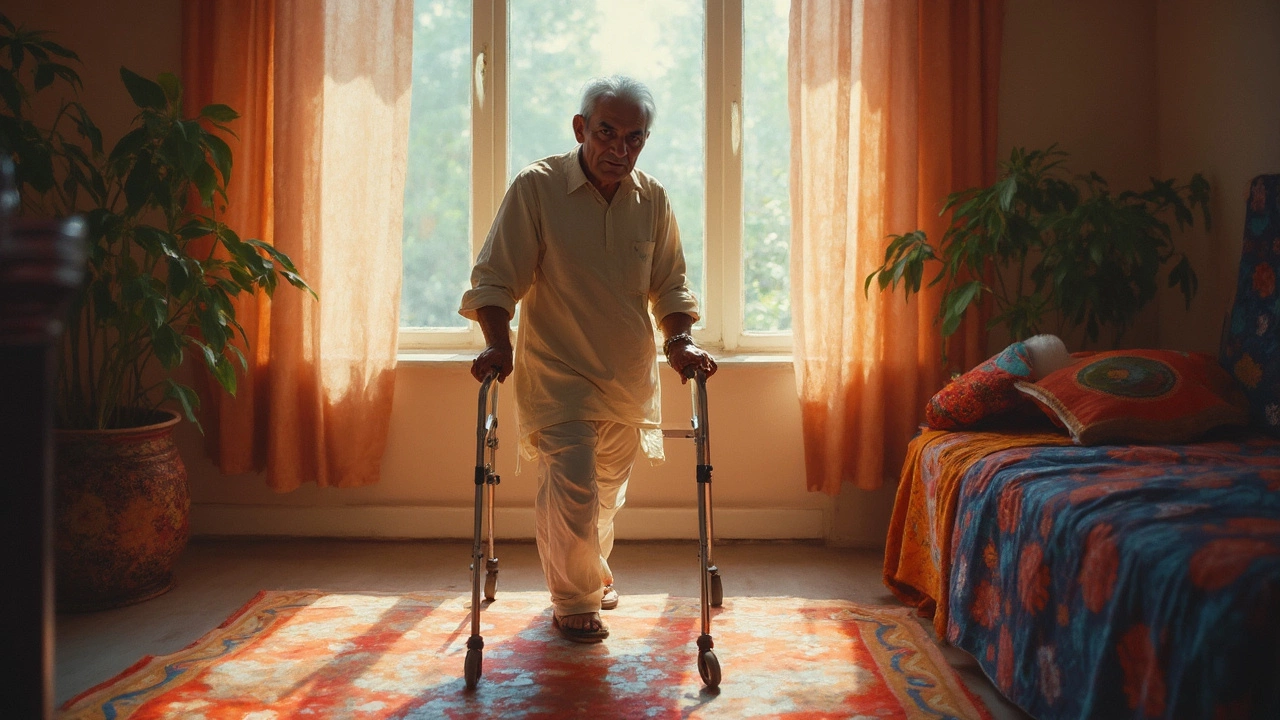
- Feb, 11 2025
- 0
If you've just gone through knee replacement surgery, you're probably wondering how long you'll be hobbling around with a walker. Well, that's not an easy question to answer since everyone's healing journey is unique. But here's the scoop—most folks ditch the walker in a few weeks.
After the surgery, a physical therapist usually helps you start moving. They might even have you out of bed on the same day. Yes, you heard that right! But don't worry, you'll be moving at a slow pace and under close supervision.
Now, about the walker. It's there to help you balance and take the weight off your new knee so you can get used to walking. Generally, you'll use it for about 2 to 3 weeks. After that, many transition to a cane as their strength and balance improve. But hey, don't rush it—taking your time ensures better healing in the long run.
- Understanding Knee Replacement Recovery
- Typical Timeline for Walker Usage
- Factors Influencing Recovery Speed
- Transitioning from Walker to Cane
- Tips for Faster Recovery
- When to Seek Professional Guidance
Understanding Knee Replacement Recovery
Healing from a knee replacement is no cakewalk—it's a journey that takes time and patience. So, what should you expect? Let’s break it down.
Initial Recovery Phase
Right after surgery, your knee will be sore and swollen. That's normal. The hospital usually gives you strong meds for the pain. You will likely start physical therapy the day of or after your surgery to begin mobilizing the new joint.
You'll find the walker crucial for keeping your balance early on. It’s not just about moving around but letting that knee get used to its new role.
Weeks Following Surgery
During the first few weeks, your range of motion and strength should gradually improve. Your healthcare team will encourage you to stay physically active and follow your therapy program diligently.
Long-Term Recovery
It can take several months to fully recover. Usually, by 3 months, most people are on the brink of gaining their independence back. By 6 months, you might be feeling significantly better, although minor improvements can continue up to a year post-surgery.
Factors at Play
Your recovery timeline might differ based on factors like:
- Age
- General health condition
- Level of activity post-surgery
- Adherence to rehabilitation
Setbacks
Sometimes, complications like infections or joint stiffness can occur. If you notice anything unusual, contact your doctor.
Remember, even if it takes longer than expected, the ultimate goal is to walk freely without the walker and enjoy the benefits of your new knee.
Typical Timeline for Walker Usage
Alright, let's break down what you can expect right after that knee replacement surgery. You'll likely wake up with a walker nearby. Your first challenge? Taking baby steps as early as the first or second day. It's a little intimidating but also empowering!
In the first week, you'll use the walker to shuffle around the house, helping you keep balance and put less pressure on the new knee. Think of it as your trusty sidekick during this early stage. By the second week, most people find strides becoming longer and less painful. The goal is to get you more mobile and independent.
Heading into week two and three, you'll notice things are getting easier. If all goes well, your physical therapist might start talking about transitioning to a cane by the end of week three. Some folks take longer, some take less time. Remember, your body's on its own schedule. No rush.
Factors That Might Affect This Timeline
So, what tricks can speed things up? Good question! A few factors can influence how quickly you phase out the walker. Here's a quick list:
- Your overall fitness level before surgery
- Whether or not you're sticking to physical therapy sessions
- Your age and general health
- How well you're eating and resting
Switching to a cane isn't a green light to sprint down the street. Ease into it. The key here is to tune in to what your body is saying. If something hurts, take it as a cue to slow down.
By week four, many people are ready to go from walker to cane. But hey, listen to your therapist—they know a thing or two about getting you up and dancing again (maybe not literally, but you get the idea!). Sticking with a rehabilitation program will make sure each step forward is a sturdy one.
Here’s a little secret: Patients who religiously follow their rehab exercises often see faster improvements. It’s like a fitness plan for your knee.
The Bottom Line
So, how long will you need a walker? Maybe three weeks, give or take. Your journey might be quicker or take a bit longer, and that's okay. Remember, it's not a race. You've got this!

Factors Influencing Recovery Speed
The road to recovering after a knee replacement is a bit like putting together a puzzle. Several pieces come into play, and each one can significantly impact how fast you regain your mobility and, eventually, ditch the walker.
Age and Overall Health
Let's start with the basics. Your age and general health really matter. Younger folks might bounce back quicker, while older individuals might need a bit more time and patience. If you're in good health and keep active, that's a definite plus. Those little walks you took before surgery pay off now.
Weight and Obesity
Your weight also plays a part in your recovery. Extra pounds mean extra pressure on that new knee. Maintaining a healthy weight can speed things up and make your rehab less challenging. Easier said than done, right? But every bit of effort counts.
Pre-Surgery Activity Level
If you were active before the surgery, you're likely to enjoy a smoother path to recovery. Those who've exercised regularly usually find that their muscles and joints adjust more rapidly to the new changes. A sedentary lifestyle might make the early days tougher, but don't lose heart; it's never too late to get moving.
Commitment to Physical Therapy
Physical therapy is the unsung hero of knee replacement recovery. Your dedication here is crucial. The exercises might feel tough, but they are golden when it comes to boosting strength and flexibility. Committing to your regular PT sessions will make a world of difference.
Support System at Home
Never underestimate the power of a good support system. Family and friends play an instrumental role in your recovery. Having folks around to help you with daily tasks and encourage you as you transition from the walker to a cane makes the journey less daunting.
Remember, everyone's path to recovery is different. But knowing these factors can help you understand what might influence your speed of getting back on your feet. Speaking of speed, here’s one thing to keep in mind—often slow and steady wins the race, especially when you're dealing with a new knee.
Transitioning from Walker to Cane
Alright, so you're a couple of weeks into your recovery, and you're probably itching to swap the walker for something a bit less bulky. Enter the cane, a smaller but mighty tool that'll give you that bit of support without cramping your style.
Most folks find that around the 2 to 4-week mark, they're ready to make the switch. But this isn't a one-size-fits-all timeline. Your pace could be different depending on factors like your overall health, age, and how religious you've been about physical therapy.
Steps to Transition
Switching from a walker to a cane involves these key steps:
- First, check in with your physical therapist. They'll assess your balance and strength to give you the green light.
- Start practicing around the house. You’re on your home turf, so it’s a safe place to test the waters.
- Use the cane on the opposite side of your healing knee. This helps you distribute weight more evenly.
- Take small steps first and gradually increase your pace as you feel more comfortable.
Signs You're Ready
There are some telltale signs that it's time to switch:
- You can walk without putting much weight on the walker.
- Your balance is improving, and you're less wobbly on your feet.
- You feel confident and ready to handle uneven surfaces, like a carpet or a slight hill.
Some people worry about switching too soon or waiting too long. The truth is, there's no harm in waiting until you're sure you're ready. It's better to be safe than sorry and save yourself from any unnecessary setbacks. While everyone hopes for a quick recovery, patience is a virtue in the knee game.

Tips for Faster Recovery
Alright, so you want to speed up your knee replacement recovery? Here are some tried and tested tips to help you back on your feet. Remember, patience is part of the game, but a little effort goes a long way.
Follow Your Physical Therapy Routine
Your recovery hinges significantly on sticking to the physical therapy plan. Therapists tailor exercises to boost your strength and improve flexibility around the knee. Missing sessions can slow down your progress. So, grab your sports shoes and get going!
Mind Your Diet
Nourishing your body with a balanced diet aids recovery. Focus on foods rich in protein, vitamins, and calcium. These nutrients promote healing and bone strength. Plus, staying hydrated is vital. So, keep that water bottle nearby.
Rest and Elevate
It might sound boring, but rest is crucial. Make sure to elevate your leg when resting to minimize swelling. This simple move can do wonders for a quicker recovery.
Stay on Top of Pain Management
Manage pain effectively by following your doctor's medication instructions. Keeping the pain in check makes it easier to engage in rehabilitation exercises. That said, don't go overboard. Use meds responsibly, people!
Avoid Overdoing It
Pushing yourself too hard might seem tempting, but it risks setbacks. Listen to your body—if it screams 'enough,' then ease up. A slower but steady pace wins this race.
| Activity | Weeks Post-Surgery | Status |
|---|---|---|
| Use of walker | 1-3 weeks | Gradually reducing |
| Transition to cane | 3-6 weeks | Start adapting |
| Light exercise | 6+ weeks | Begin cautiously |
The key to a swift and smooth recovery lies in combining these tips with consistent care and attention. Trust the process, stay committed, and soon you'll be walking around with newfound ease.
Nikhil Verma
I'm a dedicated physician with a passion for exploring the intricacies of medicine, focusing on the unique healthcare challenges in India. I spend much of my spare time writing articles aimed at improving public understanding of health issues. Balancing my clinical practice and writing allows me to reach a wider audience, sharing insights and fostering a deeper appreciation for medical advancements. I derive immense satisfaction from both treating patients and engaging with readers through my writing.